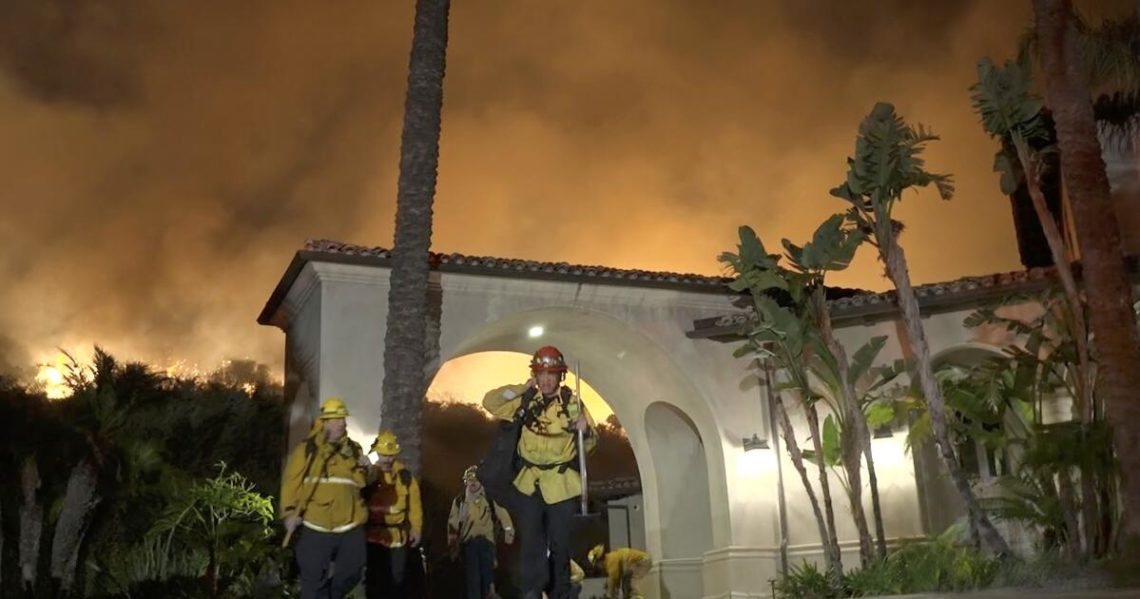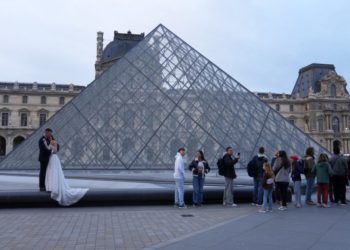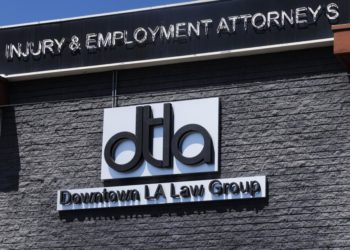A hiker clambers across a scorched landscape of ash, his footsteps crunching on charred earth as he peers over a ridge at a burn scar pocked with blackened stumps. Below are thickets of green chaparral and densely packed homes.
Suddenly, he stops. He zooms the camera in to wisps of white smoke rising from the dirt.
“It’s still smoldering,” he whispers — apparently to himself. No firefighters or state park rangers are visible.
The video of smoke on a hillside above Los Angeles’ Pacific Palisades was shot by a local resident above Skull Rock Trailhead at 11:30 a.m on Jan. 2 — nearly 36 hours after the Lachman fire ignited and long after the Los Angeles Fire Department deemed the fire “fully contained.”
The footage is one piece of a puzzle that has been the subject of so much anger, attention and investigation since the January firestorms: What happened between the time L.A. firefighters declared the Lachman fire out and when it rekindled into a catastrophic firestorm that burned huge swaths of Pacific Palisades?
The video could also be key evidence for attorneys working on behalf of thousands who lost their homes against a player that has so far not received much attention.
Ever since federal officials arrested Jonathan Rinderknecht Oct. 8 on suspicion of igniting the Lachman fire — and revealed that embers from that blaze rekindled into the Jan. 7 Palisades fire — LAFD has faced the brunt of criticism for failing to fully extinguish the New Year’s Day fire.
But lawyers representing thousands of Palisades fire victims are also focusing on another target.
They argue the state, which owns Topanga State Park, where the Palisades fire began, did not do enough to monitor the small Jan 1. Lachman brush fire and stop it reigniting six days later into the devastating Palisades fire that killed 12 people and destroyed more than 6,800 structures. Plaintiff attorneys are not alleging the state should have suppressed the fire; instead, they say it failed to make sure the area was secure.
The video, plaintiff attorneys say, corroborates the case they make in a master complaint filed earlier this month: that the state allowed a “dangerous fire condition” to exist on the Lachman burn scar. They allege the state allowed “embers from the Lachman Fire to smolder, rekindle and then re-ignite in dry brush” as the National Weather Service warned of dangerous Santa Ana winds.
California State Parks did not respond to questions on what actions it took to monitor the Lachman burn scar on Topanga State Park in the run-up to the dangerous wind event, or what role it typically plays in monitoring land after fires. It also did not respond to any of the allegations in legal filings or the hiker’s video showing smoke rising.
“California State Parks does not comment on pending litigation,” said a spokesperson for the agency.
Government officials typically have limited liability in fires. The legal doctrine of qualified immunity shields public servants from civil litigation, unless their actions violate “clearly established” law, so they can make judgments without constant legal threats and public funds are protected.
California government code specifically prevents public entities and employees from being held “liable for any injury resulting from the failure to provide or maintain sufficient personnel, equipment or other fire protection facilities.”
However, David Levine, a professor of law at UC San Francisco, said allowing a “dangerous condition” on your property offers lawyers a possible path around immunity.
“It’s going to depend on the facts,” Levine said.
It is unclear whether the smoldering depicted in the hiker’s video was on state land. Investigators from the Bureau of Alcohol, Tobacco, Firearms and Explosives determined the Lachman fire ignited on a 160-acre sliver of land owned by the Mountains Recreation and Conservation Authority before spreading to Topanga State Park. The video appears to have been shot near the border of the two properties.
Whether or not the smoke in the video was on the state portion of the burn scar, the plaintiff attorneys claim it was clear the Lachman fire was not fully extinguished.
“The rekindle happened on the State Park land and that’s what matters to our case,” said Alexander “Trey” Robertson, an attorney who represents 3,300 Palisades residents and is co-leading litigation on behalf of all victims in the Palisades fire.
Plaintiff attorneys claim California State Parks did not sufficiently monitor the smoldering earth — even as NWS warned repeatedly in the days before Jan. 7 of “critical fire conditions” and a “life-threatening, dangerous” windstorm across parts of Los Angeles and Ventura counties.
Protocol outlined in the state’s Department of Parks and Recreation Operations Manual indicates that staff should monitor burn scars: “Areas of a park unit which have burned will remain closed,” it states, “until appropriate Department staff have inspected the area and rectified any public safety, property or resource protection issues.”
Plaintiff attorneys argue that didn’t happen.
“The State failed to inspect and maintain its property and failed to provide proper fire protection on its property to allow embers from the Lachman Fire on its property,” the complaint states, “particularly in the presence of overgrown and poorly maintained dry chaparral, as well as knowledge of extreme fire weather conditions and predicted Red Flag Warning wind events.”
If a park ranger had inspected the Lachman burn scar and seen the smoke coming out of the ground, Robertson said, they could have urged LAFD to come back out and properly extinguish that fire.
It’s important to note the state has released few details about park rangers’ actions between the Lachman fire and the Palisades fire. It is possible state employees did monitor the burn scar and did not see smoke. California State Parks declined to provide details about ranger movements in the critical days between the two fires.
The area where the Lachman fire burned was not in a remote area, Robertson noted. It is just a couple minutes from a trailhead parking lot in an area popular with hikers.
“A park ranger could have very easily parked his or her truck, and walked a few-minute hike to top of the trail and just done a visual inspection,” Robertson said.
Spencer Pratt, a reality TV star who lost his home in the Palisades fire and has since become an advocate for accountability, said park managers have a duty to keep the public safe.
“It’s so obvious that they left it all smoldering — to the point where multiple hikers have videos of it still smoldering,” Pratt said. “We pay our taxes for it to be maintained. It’s in their policy manuals. It’s the law; it’s their government code: that it can’t create a danger to our town, our houses.”
What happened after the Lachman fire?
When flames lit up the hillside near Skull Rock on the Temescal Ridge Trail shortly after midnight on New Year’s Day, firefighters moved quickly to suppress the blaze.
Within minutes of getting the first 911 call, fire engines rushed to the nearest trailhead and LAFD firefighters hiked to Skull Rock on foot. County firefighters dug a handline to block the spread of the fire with the assistance of LAFD hose lines.
By 4:46 a.m., LAFD announced that firefighters had “completed the hose line around the perimeter of the fire” and it was “fully contained.” “Some resources will be released as the mop up operation continues,” it added, “to ensure no flare ups.”
The next day, when firefighters returned to collect fire hoses, “it appeared to them that the fire was fully extinguished,” according to an affidavit by a special agent with the ATF.
According to the ATF special agent, a firebrand became lodged within dense chaparral and then smoldered and burned within the roots of the vegetation. The underground burning, he stated, was not visible to firefighters or members of the public who visited the burn scar after the Lachman fire.
But that appears to be contradicted by the video taken Jan 2. A local resident shot footage showing smoke and no firefighters on site.
Five days later, the Palisades fire ignited in Topanga State Park about 20 feet south of the perimeter of the Lachman fire.
The legal case
Los Angeles firefighters have been widely criticized for their lack of preparation before the Palisades fire.
A week after the January firestorm, a Times investigation found LAFD failed to predeploy engines to the Palisades as meteorologists warned of critical fire conditions.
After the ATF announced this month that the Palisades fire was a holdover fire ignited by embers of the Lachman fire, Interim Fire Chief Ronnie Villanueva told The Times that LAFD did not use thermal imaging technology to confirm the Lachman fire was out.
But attorneys face steep odds bringing legal claims against LAFD because California government code gives public officials broad immunity against claims of negligent firefighting.
The case against the state, however, is different. Attorneys representing fire victims argue government immunity does not apply to the state’s failure to inspect its land in the days between the Lachman and Palisades fires to ensure that no smoldering embers remained that could reignite as meteorologists warned of dangerous Santa Ana winds.
The complaint cites a 1974 legal decision involving a fire at an airport owned and operated by the city and county of Imperial. The court found governmental immunity should not be used “to allow a public entity to escape responsibility from its failure to provide fire protection on property which it owns and manages itself, particularly where it has permitted a dangerous fire condition to exist on that property.”
After LAFD announced it had extinguished the Lachman fire, the complaint alleges, the state had a “non-delegable duty to inspect its property for dangerous condition given that embers in the root structure are a well-known phenomenon after such a fire, that there was heavy fuel in the form of dry overgrown, chaparral, and a serious known coming wind condition.”
It will be up to courts to determine whether state officials were actually neglectful.
Levine, the law professor not affiliated with the case, said the lawyers who filed the master complaint— a 198-page document that also targets L.A. Department of Water and Power and dozens of public and private entities — had put together an impressively detailed case. But the state could also offer counter evidence and experts might offer different opinions about how often the state would be expected to check the burn scar.
“I think what the plaintiffs are doing is saying, ‘We have a lot of ammunition here,’ and it’s kind of an invitation to consider settling,” Levine said. “It’s a high hurdle, but not an impossible hurdle, and they may have enough evidence to get over that hurdle.”
Even if they prevail, property owners might not actually get that much of a payout, Levine said, because so many of the homes that burned were insured.
“If a fire policy paid out a million dollars, say, on a house up there in Palisades, the insurance company is going to say, ‘We get our money back,’” Levine said. “So how much money would actually end up in the hands of fire victims, I think, would be somewhat open to question.”
The master complaint does not hold the MRCA liable for allowing a dangerous condition on the Lachman burn scar. But even if MRCA isn’t legally liable because the Palisades fire origin point was not on its land, the public agency dedicated to acquiring and preserving open space and parkland also faces questions about its protocol for monitoring burn scars.
The agency has its own fire crew, with 30 full-time, on-call and volunteer wildland firefighters. Its website says it deploys its fire crew on red flag days to prevent and assist in suppressing any fires and coordinates with local fire departments, which are better equipped for larger fire responses.
In a statement to The Times, MRCA said its fire crew “did not play a suppression or monitoring role in the Lachman Fire” and that LAFD “was the lead responding agency and managing authority for the Lachman Fire, working in coordination with the Los Angeles County Fire Department.”
The post ‘It’s still smoldering.’ A hiker’s video of Palisades fire raises questions about state’s responsibility appeared first on Los Angeles Times.




